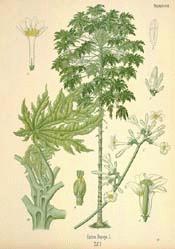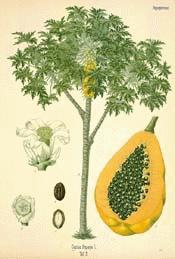
PapawBotanical: Carica papaya (LINN.)
---Synonyms---Melon Tree. Mamaeire. Papaya Vulgaris (D.C.).
|

|
(Carica papaya LINN.) |
---Constituents---The seeds of the Papaw tree contain a glucoside, Caricin, which resembles Sinigrin, also the ferment Myrosin, and by reaction of the two a volatile, pungent body suggestive of mustard oil. From the leaves an alkaloid called carpaine has been obtained; physiologically this alkaloid has the same effect on the heart as digitalis. Papain is often adulterated with starch; in cases of acidity it is said to be much superior to pancreatin because its action is not affected to any extent by its contact with the acid. This plant must not be confounded with the custard apple, which is often called Papaw and botanically known as Uvaria triloba.
---Medicinal Action and Uses---The juice of the tree or an infusion of the leaves and fruit makes the toughest meat tender when rubbed with it or cooked in the leaves; if chickens and pigs are fed on the leaves it will make their flesh tender. The ripe fruit is refreshing and palatable; it is sometimes used as a sauce; the seeds cannot be detected from capers; it is sometimes preserved in sugar or boiled like turnips. The juice is used to remove freckles; it is also a strong vermifuge. The leaves are used as a substitute for soap; when the unripe fruit is pierced with a bone knife a milky juice exudes which is collected in a basin and allowed to coagulate; this is dried in the sun and contains a propeolytic enzyme which acts as a neutral or alkaline solution, and is given for impaired digestion. Pawpain is the dried white powdered unripe juice of Papaw, a ferment, and strongly suggests pepsin in odour, taste and appearance. It is said to dissolve the fibrinous membrane in croup and diphtheria, a solution over the pharynx painted every five minutes, when injected into the circulation in large doses it paralyses the heart; it is recommended to destroy warts and epithelioma, tubercules, etc.; is not caustic or astringent, but has the virtue of dissolving muscular and connective tissue.
The fresh leaves have been used as a dressing for foul wounds; internally the juice is useful in dyspepsia and catarrh of the stomach; the juice has a tendency to deteriorate by undergoing butyric fermentation, but this can be overcome by the addition of glycerine, which preserves it without impairing its digestive power.
See PAPAW SEEDS.
[Top]
© Copyright Protected 1995-2004 botanical.com

